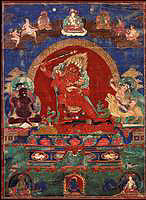
|
Tutelary Deity Raktayamari (painting no. 8)
|

View Larger Image |
||||||||||||||
|
*Published "Wisdom and Compassion" Marilyn Rhie and Robert Thurman, Taiwan Birupa the Indian progenitor of this meditation lineage is shown to the left of the central couple. Dombipa, Birupa's student is shown astride a tiger at the right. M. Mokotoff 4-98 RAKTA YAMARI (Tibetan: shin je she mar, English: the Red Enemy of Death); an emanation of the bodhisattva of wisdom Manjushri. With one face and two hands the right holds aloft a vajra stick ready to strike and the left a skullcup held to the heart embracing the consort Vajra Vetali. Very fierce in appearance with the hair flowing upwards like fire, he has large eyes and a gaping open mouth. The right leg is bent and the left extended standing above a black corpse and reclining red buffalo. The consort holds a skullcup with the left hand and stands with the right leg down and the left embracing the partner; in the same fierce demeanor as Rakta Yamari. Wearing bone and jewel ornaments, silk garments, he wears a necklace of fifty freshly severed heads and a lower garment of tiger skin. She wears a necklace of skulls and a leopard skin; completely surrounded by the flames of pristine awareness. To the left is the Indian mahasiddha Virupa, brown in colour, with the two hands held in the Dharma Teaching mudra (gesture). On the right side and riding a tiger is the mahasiddha Dombi Heruka and his tantric consort. Virupa is the first human lineage holder of the oral tradition and his student Dombi Heruka was the main recipient. At the top center is Vajrasattva, the essence of Vajradhara, white with one face and two hands holding a vajra to the heart and a bell turned up at the hip. To the left is buddha Vajradharma, red, with the two hands holding a vajra and bell crossed at the heart. Next is the Indian mahasiddha Saraha holding an arrow and mahasiddha Shavaripa in a dancing posture holding a bow on the shoulders. At the right side is green Vajravidarana in the same appearance as Vajrasattva. Again on the right is Arya Nagarjuna wearing monastic robes and a canopy of snakes shading the head. Next to him is a seated mahasiddha. At the bottom left is green Tara, deity of activities, with one face and two hands holding with the left a stem of an utpala flower to the heart. In the center is the bodhisattva Vajrapani, wrathful, blue in colour. To the right is White Tara, deity of long-life. Stylistically these three figures are necessary to balance the lower portion of the painting with the row of deities portrayed along the top. The Main Indian Lineage: Vajradhara, Manjushri Yamari, Jnanadakini, mahasiddha Virupa, Dombi Heruka, Viratipa, Matigarbha, Gambhiramati, Vajrasana Ashokashri, Nishkalangka Devi, Revendra Prabha, Chag Lotsawa Choje Pal (a Tibetan), etc. There were many lineages of Rakta Yamari to enter Tibet and most are traced back to the mahasiddha Virupa. The painting style shows a strong Nepali influence indicated by the bright red and blue colours along with the tight detailed flame patterns surrounding the central figure. The painting lacks the strongly stylized landscape backgrounds typical of Chinese influence and Eastern Tibet, and exhibits a more rigid presentation of form and colour typical of Southern Tibet. J.Watt 6-98
|
|||||||||||||||
Photographed Image Copyright © 1999 Shelley & Donald Rubin Foundation
|
|
| |
Next Image |